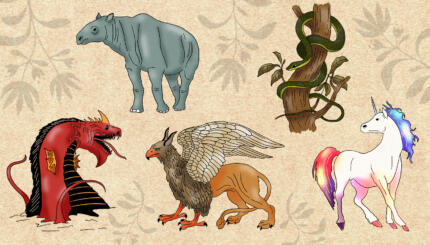Commentary on Parashat Vayakhel, Exodus 35:1-38:20; Numbers 19:1-22
As we distance ourselves from the sin of the Golden Calf, we are once again engaged in building the Mishkan, the Tabernacle that will be the focal point for all Divine encounters. The fabrics, gems and precious metals are of many kinds and Israel has been astoundingly generous.
Amid the myriad materials donated are skins of a certain animal; in Hebrew it is called a “tachash.” The Jewish Publication Society (JPS) translation of this portion hazards a guess and translates these skins as those of a dolphin with a disclaimer saying that the Hebrew is “uncertain.” In Hillel’s Bronfman Edition of the Five Books of Moses, Everett Fox translates tachash as “tanned” skins. Others have offered “sealskins.”
The earliest Aramaic translation, the Targum Onkelos, translates the word tachash with an equally cryptic Aramaic word, “sas-gavna” which later talmudists endeavor to unpack. Here are some sources for you to ponder:
The Babylonian Talmud: Tractate Shabbat 28a “Sas-gavna,” The word “Sas” comes from the Hebrew and means joy, “gavna” means colors. Its rainbow quality brings joy.
With your help, My Jewish Learning can provide endless opportunities for learning, connection and discovery.
Your Talmud Navigator
From this Rav Yosef of the Talmud understands Onkelos as saying that these skins are described as the animal’s “coat of many colors,” but what kind of animal is it?
A modern commentator, Rav Menachem Kasher, sees the word “sas-gavna” as being of Aramaic origin. A “sas” is a worm, and “gavna” means color. He understands that this animal radiated the many colors that one may see in a caterpillar, or colorful worms. It becomes an adjective describing the colors of the hides.
The following midrash (Midrash Tanchuma Vi) takes us deep into the realm of rabbinic imagination:
R. Yehudah and R. Nehemiah disagreed about the nature of the Tachash.
Rabbi Yehudah said: It was a huge kosher animal in the desert, and it had one horn in its forehead, and its hide had six colors from which they made the curtains of the Tabernacle.
Rabbi Nehemiah said: It was a miraculous beast that was hidden away after it was used in the Tabernacle. Why was it necessary to create such a beast? It is written that the curtains of the Tabernacle were thirty cubits long. And it is written that the skins of the Tachash that were used for the curtains were also 30 cubits long. What animal hides are 30 cubits long? Rather it was a momentary miracle that was hidden away soon after it happened.
Your Midrash Navigator
1. Do you see the definition of Onkelos as the Talmud understood it, surface here?
2. What has been added?
3. Rabbi Yehudah made a point of saying it was a kosher animal, why?
4. Does Rabbi Nehemiah consider this fact important?
5. According to Rabbi Nehemiah, why does the fact that the skins needed to be thirty cubits long require a miracle?
6. Do Rabbi Yehudah and Rabbi Nehemiah disagree? If so, how? In yet a further discussion in the Jerusalem Talmud, and other places the tachash was not considered a kosher animal.
Combining these different points of view, Rabbi Levi Yitzchak of Berdichev, one of the great modern Hasidic masters, viewed the Tachash as a metaphor for the layers of meaning behind a person’s speech. He saw the hide of the tachash as something that was unattractive — even impure — on the outside, but magnificent on the inside.
He likened this to the nature of humor. Sometimes, he said, a joke can be seen as frivolous and lacking any spiritual value whatsoever, but often, it has the power to penetrate a person’s consciousness and lead him to an awareness of heaven in a way that is completely surprising. What seemed to be a distraction from the work of the spirit ends up being spiritual work of the highest order.
Many times spiritual magnificence is cloaked within the garments of that which may not seem so kosher. The jokers are often the most serious among us. The idea that the Tabernacle where God dwelled includes this lesson reminds us that the deepest connections are not necessarily those that seem most apparent.
Provided by Hillel’s Joseph Meyerhoff Center for Jewish Learning, which creates educational resources for Jewish organizations on college campuses.
Hasidic
Pronounced: khah-SID-ik, Origin: Hebrew, a stream within ultra-Orthodox Judaism that grew out of an 18th-century mystical revival movement.
kosher
Pronounced: KOH-sher, Origin: Hebrew, adhering to kashrut, the traditional Jewish dietary laws.
Midrash
Pronounced: MIDD-rash, Origin: Hebrew, the process of interpretation by which the rabbis filled in “gaps” found in the Torah.
Shabbat
Pronounced: shuh-BAHT or shah-BAHT, Origin: Hebrew, the Sabbath, from sundown Friday to sundown Saturday.
Talmud
Pronounced: TALL-mud, Origin: Hebrew, the set of teachings and commentaries on the Torah that form the basis for Jewish law. Comprised of the Mishnah and the Gemara, it contains the opinions of thousands of rabbis from different periods in Jewish history.


